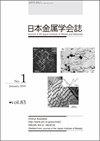Electron Theory on Grain-Boundary Structures and Local Magnetic Properties of Neodymium Magnets
IF 0.4
4区 材料科学
Q4 METALLURGY & METALLURGICAL ENGINEERING
引用次数: 4
Abstract
A fundamental understanding of microstructures is indispensable in improving neodymium-magnets performance at high temperatures. Thus, it is of signi cant importance to clarify atomic structures and local magnetic properties of interphase interfaces in microstructures, based on electron theory. We studied interfaces between the main phase of neodymium magnets, Nd2Fe14B, and a subphase NdOx using massively parallel rst-principles electronic-structure calculations with the K computer. As well as the known Cu-addition effect on wettability improvement in metallic Nd subphase, we recognized that some of the added Cu atoms at the (001) interface improve the local magnetic anisotropy of Nd at the interface. Furthermore, we found that the substitution of Fe in the (001)-surface of main-phase grains with Zn can also improve the stability of magnetic anisotropy. [doi:10.2320/matertrans.M2017258]钕磁体晶界结构和局部磁性能的电子理论研究
对微观结构的基本理解是提高钕磁体在高温下的性能必不可少的。因此,基于电子理论研究微观结构中相界面的原子结构和局部磁性具有重要意义。我们研究了钕磁体的主相Nd2Fe14B和子相NdOx之间的界面,使用K计算机进行了大规模并行的第一性原理电子结构计算。除了已知的Cu添加对金属Nd亚相润湿性的改善作用外,我们还认识到(001)界面上添加的一些Cu原子改善了界面上Nd的局部磁各向异性。此外,我们发现在主相晶粒(001)表面用Zn取代Fe也可以提高磁性各向异性的稳定性。(doi: 10.2320 / matertrans.M2017258)
本文章由计算机程序翻译,如有差异,请以英文原文为准。
求助全文
约1分钟内获得全文
求助全文
来源期刊

Journal of The Japan Institute of Metals
工程技术-冶金工程
CiteScore
0.70
自引率
0.00%
发文量
27
审稿时长
6-12 weeks
期刊介绍:
Information not localized
 求助内容:
求助内容: 应助结果提醒方式:
应助结果提醒方式:


